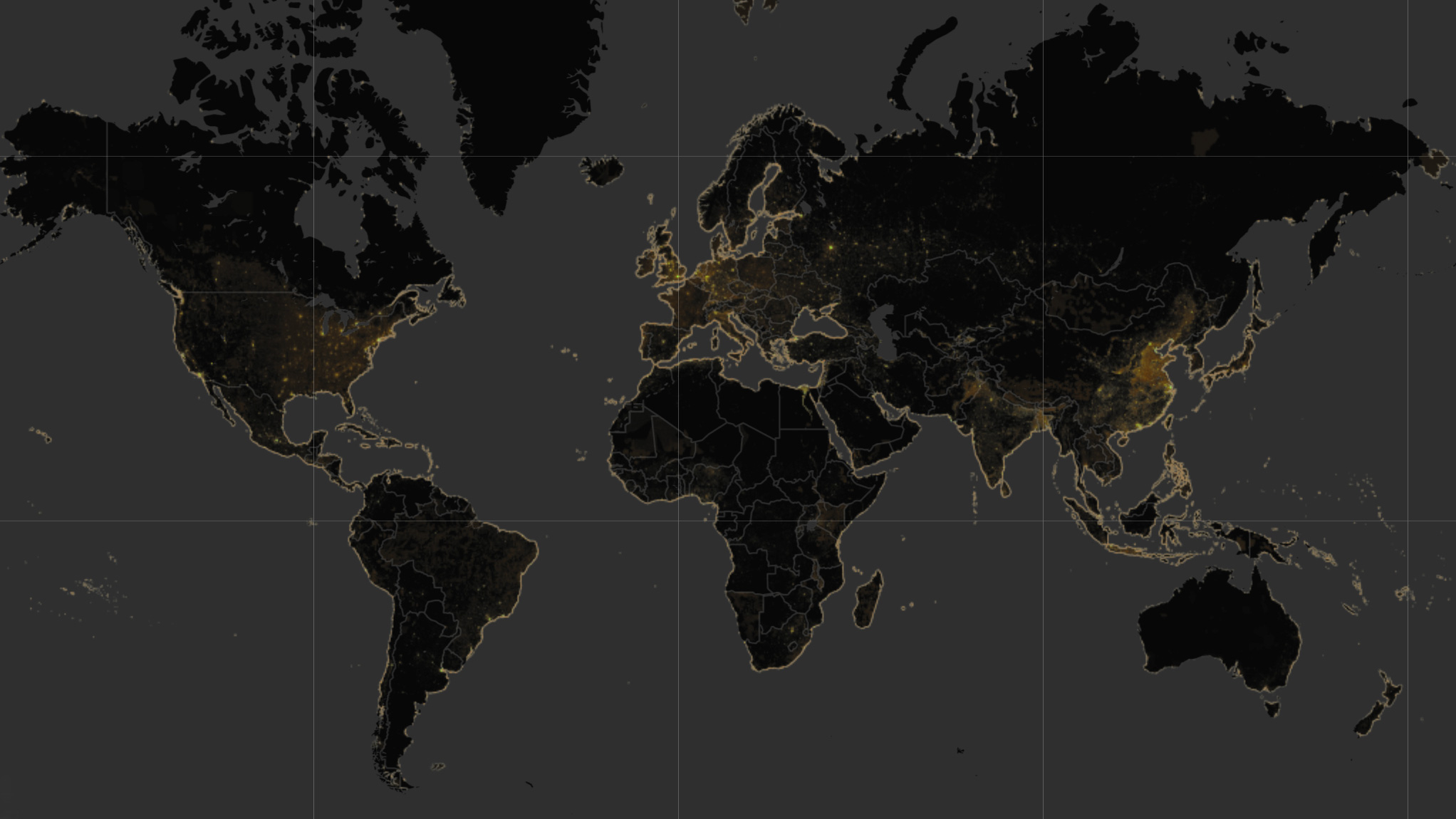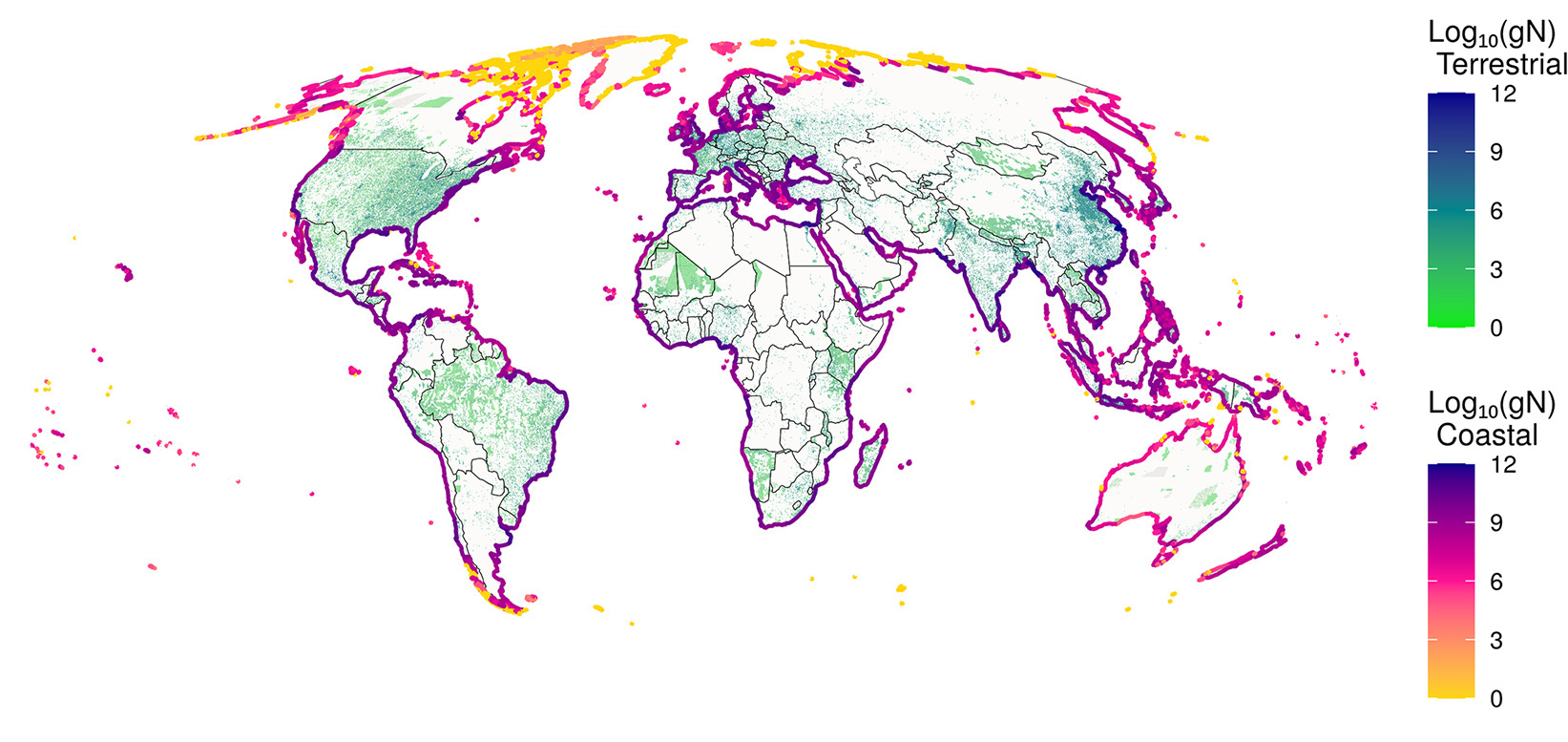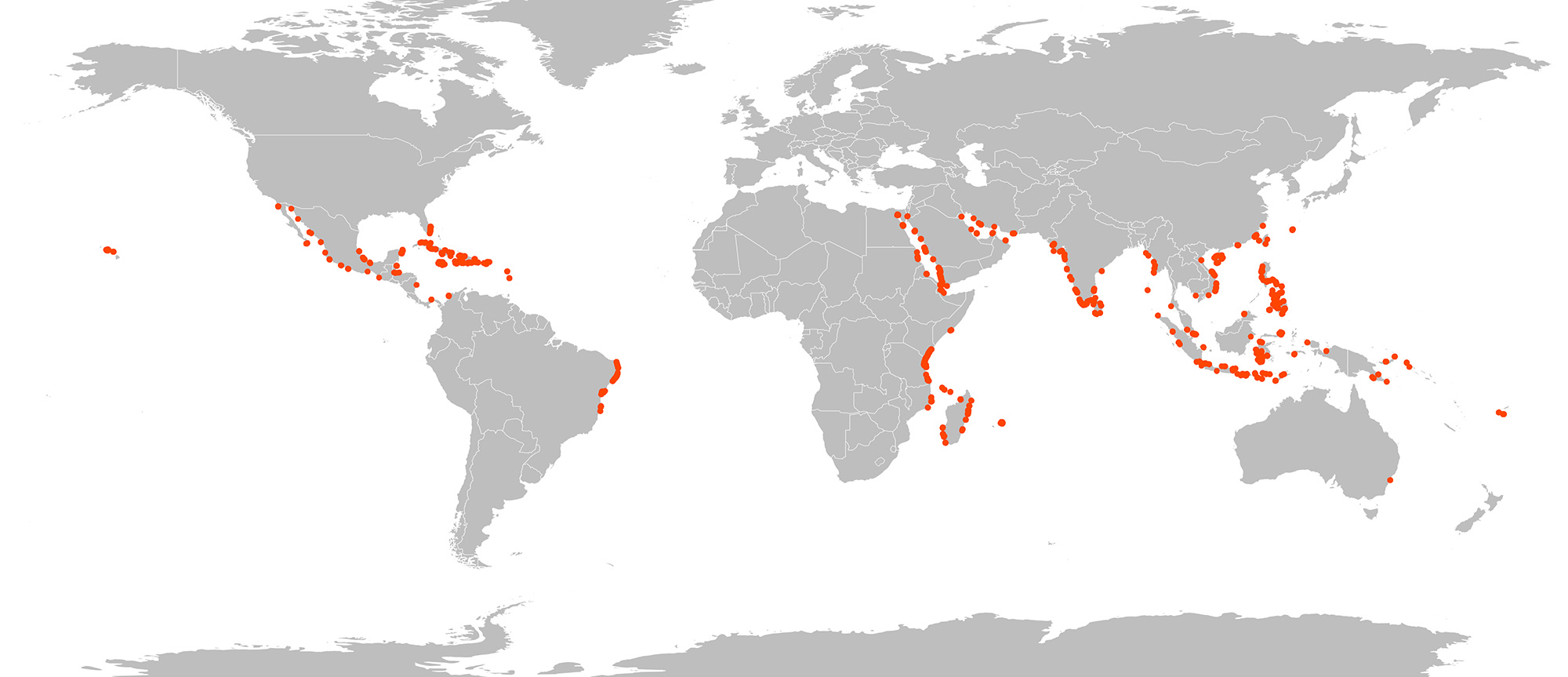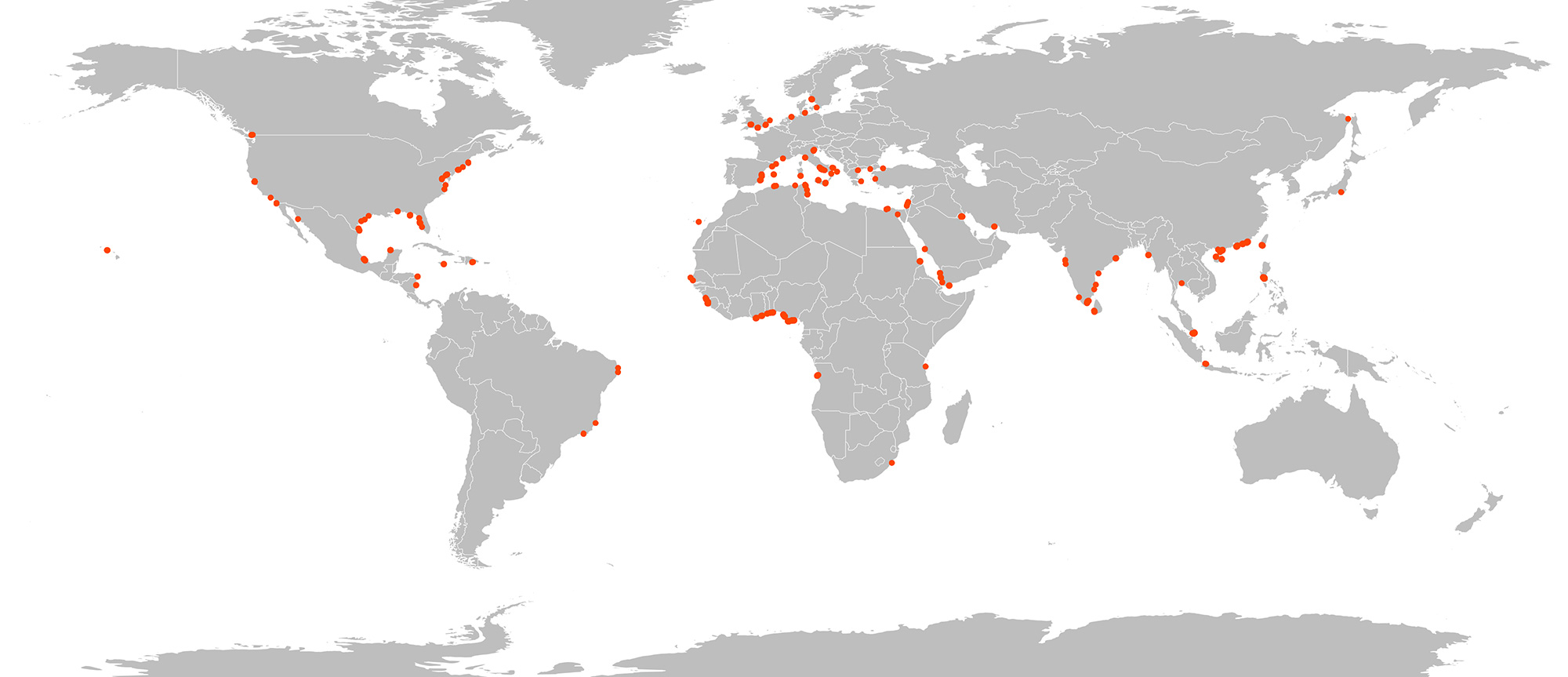A new study from a team of researchers at UC Santa Barbara and Columbia University is the first of its kind to map nitrogen inputs from wastewater pollution in 130,000 watersheds around the world. Our Shared Seas interviewed Dr. Ben Halpern, one of the study co-authors, to unpack research findings and learn how the conservation community can target efforts that address wastewater pollution and protect ocean and public health.

Global nitrogen inputs into coastal waters from wastewater. Captured from GlobalWastewaterModel.com
You recently published a paper mapping global sewage input into the ocean. What are some of the most interesting headline findings from the paper?
I’ve long thought about the different ways human activities impact the ocean. There are many. For land-based inputs into the ocean, these pressures come from excess fertilizer use, pesticides, and urban runoff, for example. Until recently, I’d never thought about wastewater much, in large part because science and policy have predominantly focused on agriculture, particularly runoff from fertilizer and livestock manure, which is a major source of nitrogen input into watersheds and ultimately coastal waters. Once we started researching wastewater, we realized what a big deal it was. We didn’t discover this—people have long known that wastewater was a source of nitrogen input into the ocean—but no one really understood how much of it was going into the ocean and where, or had mapped where it was coming from.
The headline result is that wastewater contributes nearly half as much nitrogen to our ocean as does agriculture and livestock. That’s a huge amount, and can lead to eutrophication and dead zones, among other problems.
The headline result is that wastewater contributes nearly half as much nitrogen to our ocean as does agriculture and livestock. That’s a huge amount, and can lead to eutrophication and dead zones, among other problems.
The second big finding is the input of wastewater into coastal waters is highly variable. Almost half of all wastewater input is from five countries and around 10 different major watersheds. Those are key spots—the Mississippi River is a great example—with huge inputs, just huge, that are having a really big impact on coastal areas. We’ve ranked these hotspots, which can help with priority setting in terms of mitigating the impact of wastewater on coastal habitats.
A third big finding is tied to our mapping of the sources of wastewater inputs. Wastewater inputs come from direct input, septic systems, and treated sewage. The relative proportions of those inputs across various geographies can powerfully inform strategies for mitigating wastewater inputs. Some countries, like the United States, are almost entirely on sewered or septic systems, whereas in other countries, like India, there is more direct input, or open defecation. These results give us key information to find effective and efficient solutions to wastewater mitigation.
Almost half of all wastewater input is from five countries and around 10 different major watersheds.
Fig 1: Global distribution of total wastewater nitrogen

Global map of the terrestrial sources (green to blue) and coastal diffusion of inputs (yellow to purple) of total wastewater nitrogen (N), measured in log10(gN) in both. Coastal plumes have been buffered to line segments to exaggerate patterns to be visible at the global scale. Adapted from Tuholske C, Halpern BS, Blasco G, Villasenor JC, Frazier M, Caylor K (2021) Mapping global inputs and impacts from of human sewage in coastal ecosystems. PLoS ONE 16(11): e0258898. https://doi.org/10.1371/journal.pone.0258898
In what way is this analysis novel or significant?
This paper provides much higher-resolution information about where wastewater is coming from that we didn’t have before, as well as what kind of treatment it is or isn’t getting and where it ends up. There had been some data about wastewater input at the country level before, but our mapping of the different sources and ultimate destinations of wastewater, at a high resolution globally, is new.
This high-resolution mapping is important because it opens up all sorts of important pathways for informing management and conservation. Perhaps most importantly, it helps connect what happens on land to what happens in the sea. For the most part conservation is siloed—if it happens on land, we deal with it on land, and if it happens in the ocean, we deal with it in the ocean. But, and of course coastal ecologists and conservationists know this well, what happens on land affects everything on the coasts and in the ocean. We were able to show another key link in a way that hadn’t really been done before. The model not only gives us important scientific information but also is a powerful tool for improving management of this issue.
For the most part conservation is siloed—if it happens on land, we deal with it on land, and if it happens in the ocean, we deal with it in the ocean. But, and of course coastal ecologists and conservationists know this well, what happens on land affects everything on the coasts and in the ocean.
Figure 2. Total Nitrogen input into exclusive economic zone (EEZ) waters of coastal countries, by source type (sewer, septic, direct)
You were able to identify a number of hotspots where nutrient inputs are especially high. Where does sewage pollution in the ocean seem to be the most severe and why do you think that is?
Not at all surprisingly, the largest watersheds input the most nutrients, simply because they aggregate inputs over a huge area. For example, the Mississippi River watershed is something like half of the entire continental United States. All the inputs from that area get aggregated and enter the ocean at one pour point off the coast of Louisiana. Because you have a lot of volume, it then spreads out along the coast and affects a large area. China has two or three large watersheds like that, including the Yangtze River. In Europe, it’s the Danube River watershed.
What I think is less obvious is the work we did to understand where coral reefs are being exposed to sewage. Coral reefs only occur in tropical and subtropical waters within this tropical band around the equator. In that part of the world, watersheds are often smaller, so you don’t get that huge watershed effect. However, you are getting lots of people living on or near the coasts where there are coral reefs, which are very sensitive to nutrient input. In our paper, we were able to map where coral reefs are being exposed to wastewater input and to what extent. There are a lot of hotspots globally where wastewater enters the ocean really close to coral reefs, which are likely being impacted. This is happening in key areas of coral reef diversity—in the Caribbean and around Indonesia, for example.
In our paper, we were able to map where coral reefs are being exposed to wastewater input and to what extent. There are a lot of hotspots globally where wastewater enters the ocean really close to coral reefs, which are likely being impacted. This is happening in key areas of coral reef diversity—in the Caribbean and around Indonesia, for example.
Figure 3. Impact of nitrogen on sensitive coastal habitats
Global map of wastewater hotspots overlapping with coral habitat

Map shows where coral reefs are heavily impacted (raster cells in top 2.5% of exposure; red dots). Raster cells are represented as points which visually over-represents the habitat; red is overlaid on top which makes it visually dominant. Adapted from Tuholske C, Halpern BS, Blasco G, Villasenor JC, Frazier M, Caylor K (2021) Mapping global inputs and impacts from of human sewage in coastal ecosystems. PLoS ONE 16(11): e0258898. https://doi.org/10.1371/journal.pone.0258898
Global map of wastewater hotspots overlapping with seagrass habitat

Map shows where seagrass beds are heavily impacted (raster cells in top 2.5% of exposure; red dots). Raster cells are represented as points which visually over-represents the habitat; red is overlaid on top which makes it visually dominant. Adapted from Tuholske C, Halpern BS, Blasco G, Villasenor JC, Frazier M, Caylor K (2021) Mapping global inputs and impacts from of human sewage in coastal ecosystems. PLoS ONE 16(11): e0258898. https://doi.org/10.1371/journal.pone.0258898
The primary focus of the paper was more on mapping wastewater distribution, rather than the actual impacts of wastewater on these ecosystems. Given the levels of exposure you modeled in some seagrass and coral ecosystems, how concerned should we be about this threat to those ecosystems?
We’ve identified the absolute and relative amounts of exposure to these habitats—that is powerful. Of course, we don’t know whether that translates into actual ecosystem impacts. We think they are likely quite significant and that it is a major concern based on what other researchers have found. We need to get in the water to see what’s happening, but we’ve created a powerful predictive model of where we think those impacts are likely to happen. Our model can strategically guide research to where to start looking for these impacts and where they may be most severe and worrisome. It allows us to really focus on prioritizing key areas for action.
It’s been said that all good research answers some questions, but leaves us with new, better questions. What questions do you think we should be asking now?
There is a huge research opportunity to get more nuanced and detailed spatial maps of how wastewater enters the environment and ends up in coastal areas at a regional scale. Another key research topic is to ground truth what that exposure to sewage means for these coastal ecosystems. Researchers can use our model to find areas to study what’s happening with corals, for example, and whether that matches what our model predicts. Then that helps us improve our model.
What is next for your team’s research on this topic?
The reason I got into wastewater research was because it’s one of many things that impacts coastal waters and oceans in general. We’re really excited about folding this research back into even broader efforts where we try to understand the cumulative effect of all human activity on coastal waters. We could then assess, for example, the contribution of wastewater’s impact relative to fishing and to climate change, or to any other threats.
Then, if we were trying to protect a specific coastal ecosystem or coral reef, we would know the relative contribution of different pressures or stressors to that system and how to prioritize action. In some places, maybe wastewater is a tiny fraction of what’s happening there, and even though it’s not great to have that wastewater pollution, with limited resources for protecting coral reefs management should focus on climate change and overfishing. However, I guarantee you that there will be places where wastewater is the dominant threat. To know that and to be able to recognize that if we really want to help coral reefs, for example, we need to deal with wastewater will be important and exciting. That’s kind of where we’re looking to go with our research from here.
However, I guarantee you that there will be places where wastewater is the dominant threat. To know that and to be able to recognize that if we really want to help coral reefs, for example, we need to deal with wastewater will be important and exciting. That’s kind of where we’re looking to go with our research from here.
Does this research change how you think about nutrients and wastewater as a relative threat to coastal ecosystems?
Absolutely. At a minimum, sewage is on my radar in a way that it wasn’t before because of this project. Knowing how big of an issue it is relative to the things that get so much attention, like fertilizer runoff, has really made me realize that this is a bigger issue than I previously thought. The people who study this for their careers have been paying attention to it, but the broader conservation community is not as aware of it. To be able to be part of the effort to raise awareness of this issue is exciting. I’m new to it, but hopefully that new perspective and the research, results, and tools we bring to bear in that conversation will help those who have spent their careers on this issue elevate the message and do more with it.
At a minimum, sewage is on my radar in a way that it wasn’t before because of this project. Knowing how big of an issue it is relative to the things that get so much attention, like fertilizer runoff, has really made me realize that this is a bigger issue than I previously thought. The people who study this for their careers have been paying attention to it, but the broader conservation community is not as aware of it.
